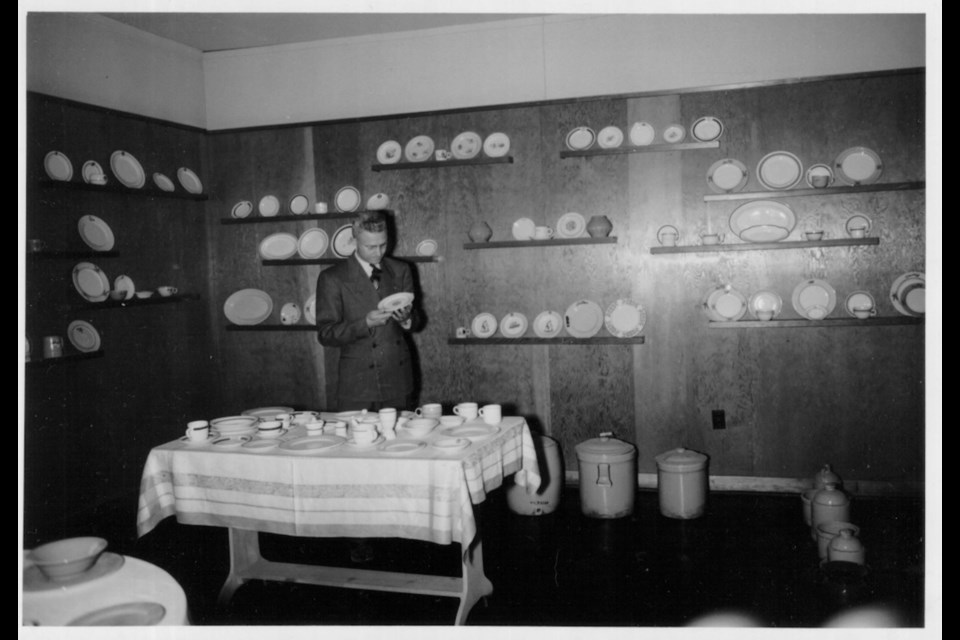Like people, sometimes china plates have an interesting history.
A 1952 Pacific Great Eastern Railway (PGE) china saucer was recently unearthed during a building upgrade at the ߣ������railyards.
The rail company operated diner cars that would have served meals on the white and yellow chinaware, crafted by Alta., between ߣ������and Quesnel from about 1948 until about 1956.
The ߣ������ reached out to folks at Medalta, which is now a museum, to see if we could find out more about the history of this dinnerware.
Who designed it?
It turns out PGE plates' design was created by Tom Hulme, who was the Art Director of Medalta's art department between 1929 and 1954, according to Raene Poisson, collections manager at Medalta.
"The banding around the ceramics would have been done by the largely female staff members in the department. The design in the middle would have been applied as a stamp."
She also had some interesting anecdotes about the style of the ware, how they were developed, and the distinct yellow colour seen on the PGE saucer.
According to Poisson, in the 1930s, Medalta was "barely surviving" after the Great Depression.
"Not only that but a competitor — Medicine Hat Potteries — poached many of Medalta's staff due to promising better wages and working conditions," she said.
Instead of giving up, in 1936, Medalta's owners decided to invest $250,000 — roughly $4.36 million in today's dollars — to upgrade the factory.
"All because of the confidence they had in 26-year-old Ed Phillipson's ceramic engineering," Poisson said.
The Phillipson influence
Phillipson immediately ordered new mass-production equipment for the factory.
"Introducing efficient work practices and experimenting with new clay bodies. He developed a new product line for Medalta — hotel ware, also called hotel china.
"After considerable testing, it was discovered that the white clay beds in Willows, Saskatchewan, would produce a good-semi porcelain product," Poisson said
Within one year, Phillipson developed a whole new line of products designed for restaurants: platters, plates, cereal and soup bowls, salad dishes, pitchers, tea and coffee pots, cups and saucers, creamers, sugar and butter dishes, egg cups and even gravy boats.
"This hardy and break-resistant hotel ware saved Medalta from financial ruin," Poisson said.
Phillipson then secured a lucrative deal with the Canadian National Railway.
Before 1946, the railway had been importing its distinctive yellow-bordered plates from England.
Poisson said that the railway brass told Medalta they weren't satisfied with the product they were receiving from overseas because the dishes scratched easily and left grease stains.
Phillipson was able to come up with a solution that pleased the national railway.
"Instead of applying the colour as an underglaze like the English company, he applied it as a yellow-stained clay slip, which melted into the raw body when fired. From there, a clear glaze was applied overall. Medalta's canary yellow didn't fade, stain, or scratch."
Medalta took over hotel ware production for the Canadian National Railway, half of the Canadian Pacific Railway and most restaurants and hospitals in Alberta, Poisson said.
"And we can see that the colour also attracted the interest of the PGE Railway," she said.
Phillipson stayed on as Medalta's superintendent until 1953.
Got china?
Poisson said anyone with Medalta Potteries, Medicine Hat Potteries, or Hycroft China products they would like to know more about could email her at [email protected].
"I'm happy to help folks learn more about their family heirlooms," she said.
Bookmark squamishchief.com so you can return for more local stories like this. Get ߣ������news daily in our free newsletter. Sign up here.





